Enjoy Slow Travel and Living in Playa Samára, Costa Rica
Article and photos by Paul Graham France
Resources updated by Transitions Abroad 3/14/2024
I ventured to the sleepy beach town of Playa Sámara on Costa Rica’s Pacific coast Nicoya peninsula — and stayed for two years. Revisiting for an extended stay, I reflect on how this magical place made me realize how slow travel is one of the best ways to see and experience the world meaningfully.
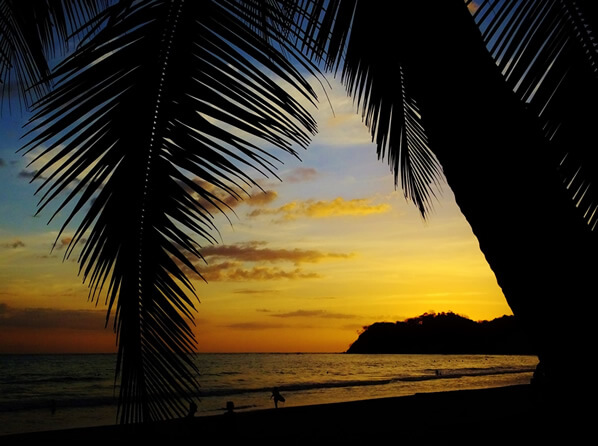
|
|
Another day of "Pura Vida" closes with an incredible sunset over Playa Sámara.
|
A Travel Elective
There are clearly no courses offered to learn how to practice slow travel. However, more and more advice is being offered as ideas have increased due to the influence of Slow Food and related Slow Travel movements. Like Slow Food, a slower form of travel has become an enticing option and counter to our fast-paced (digital) world. But no need to take a class to travel. Why not teach yourself if you are open, curious, and patient? Why not open your senses and immerse yourself in your surroundings, stay longer in fewer places, and try to create a more simple and sustainable balance between needs and desires? You will likely be amazed how quickly sensitivity to natural surroundings, as well as respect for the local people and cultures who host you on their land, will transform a “fun vacation” to one in which you practice a sustainable form of the art of travel. One of the rewards of this new perspective leads to cultivating travel experiences that save you money and allow you to keep traveling indefinitely. Playa Sámara is an excellent place to experience what Ticos (as Costa Ricans call themselves) mean by Pura Vida. Such a peaceful place might set you on your way to learning a unique mode of independent travel.
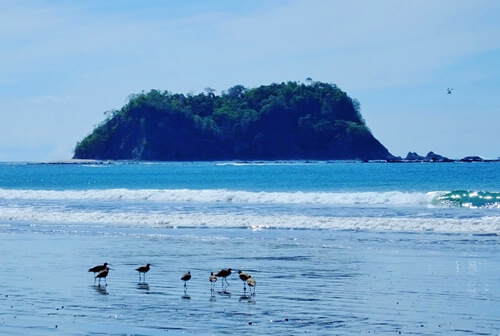
|
|
Swim out to Isla Chora or snorkel the calcified coral reef.
|
On Sámara Time: Some Things Never Change
Fortunately, some things never change. I am still gently awakened by the rush of the surf as the sun rises, a birdsong harmony, distant monkey howls, or an iguana’s shuffling across the hot tin roof. Butterflies still flutter across the surface during calm seas as pelicans circle and dive. Gallo Pinto, plátanos y fruta remains a typical Tico breakfast consisting of a simple rice and black bean dish accompanied by fried plantains and plenty of fruit. Local fishermen return twice a day with a bountiful fresh catch. Travelers and locals gather on the beach to witness dramatic sunsets every evening.
Life slows down almost immediately once you step on the sand and behold the varying blues of the bay, bordered by rocky jungle-topped points all wrapped up in a million shades of green. As I sit at one of the few beach locales and sip a famous exotic fresh fruit, Batido, thoughts refresh my soul like epiphanies. Even the most stressed escapee from the modern world will likely realize: “I am now living on Sámara time.”
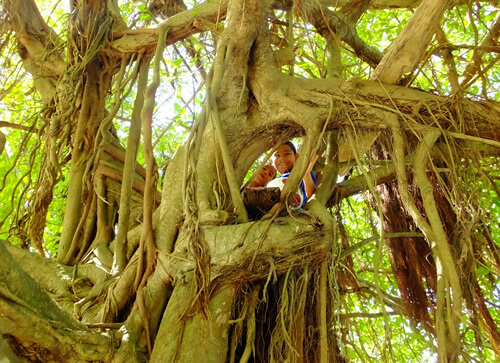
|
|
Boys will be boys, even living in a "blue zone."
|
Pura Vida!
It is almost impossible to classify why Sámara is such a special place. Perhaps because the Nicoya peninsula is one of the few Blue Zones, and an example demonstrating greater human longevity due to the simplicity of living? Maybe it is the unique combination of the ocean, fresh breeze, the millions of tropical rainforest greens, vibrant flowers, abundant fresh food, and wildlife? The consensus among locals and travelers is that they are visiting and experiencing a kind of paradise translated as pura vida. Whatever the source of the magic, whether a state of mind or a gift from the gods, the atmosphere is omnipresent. Of course, such sensations are not felt unless you are open to local life and perceive the allure. A tourist could easily sunbathe, lay by a pool, enjoy cocktails, go out to eat, and relax in their room — and it would be considered a great vacation by many who may need the relaxation. However, such tourists might well miss out on immersing themselves deeply in a new place and culture, which is part of what justifies staying in one location for as long as possible.
Pura Vida, literarlly translating to " pure life," is the Tico phrase reflecting Costa Rican beauty and pride. However, the expression also symbolizes everything from a greeting to an exclamation. The phrase is culturally rich in nuance and can be interpreted in many contexts, from endearing to cynical. Therefore, there is no absolute definition of Pura Vida. Nevertheless, after living and traveling extensively in Costa Rica, I interpret the meaning as follows: Living simply by appreciating and being content with natural surroundings, family, and friends, and creating the best situation out of the lot in life one is given. Such a minimalist yet suggestive worldview could educate and inspire us all.
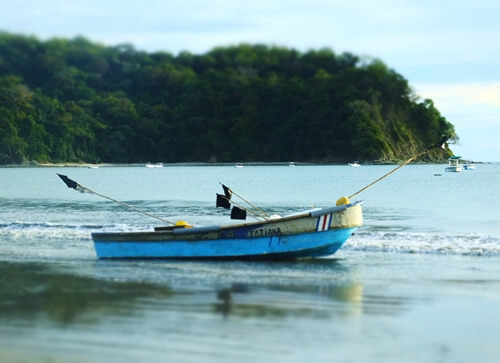
|
|
A fishing boat in the tranquil ocean.
|
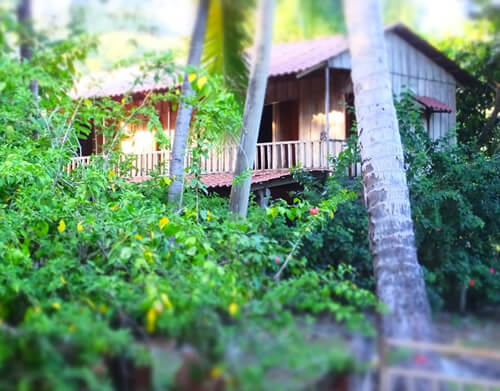
|
|
A typical modest house.
|
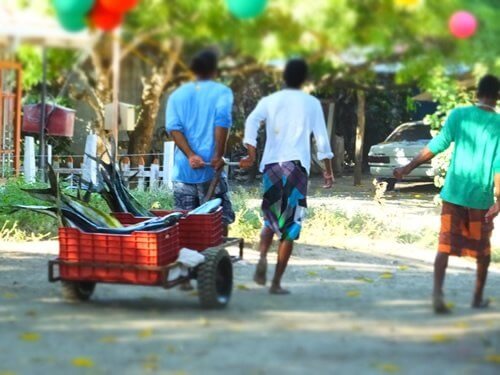
|
|
Matapalo fishermen return after a day at sea.
|
A Return to My Matapalo Home
I return to Matapalo. The neighborhood is composed of a handful of modest, colorful houses along Sámara beach, made up mostly of local fishermen and families of shopkeepers who work in Sámara center — yet quieter and genuinely Tico.
Entering the one pulperia (small grocery store), I find Jandro and his mother, the owner, conducting business as usual. Jandro recognizes me. This time, he assures me, “Your Spanish is better.” I ask about rental apartments. His mother, Maria, nods, giggles, and shows me a one-room flat behind the shop for less than the cost of a hostel dorm room. At first, she was reserved, but now we talk on the phone occasionally. Being in a small barrio like Matapalo, I started to observe what was happening in the community. I began actively greeting and meeting new and old faces from my patio.
“Pura vida mae” (mae = dude, mate) is how I greet a few fishermen hauling the day’s catch in a wagon. I ask them for some fish. They invite me with a wave towards the pescaderia. At the fish store, fish are loaded into fridges or filleted by the kilo for sale. I visit Ricardo often to buy and talk fish, but his jokes still elude me despite my best efforts to understand his sense of humor. I first tried making Ceviche (fresh, raw fish cured in lemon juice combined with peppers, onion, and garlic). Ricardo liked my first attempt.
Maria’s daughter bakes in a little room that has been turned into a kitchen for extra income, right next to my flat. As a result, I eat more cake than usual right where I live. Eduardo, the father, I recall as a local cab driver. Now, he has an SUV and makes day trips. I occasionally watch Hollywood movies subtitled in Spanish on the shop TV with Jandro. We laugh as little scenes play out while customers come and go.
Living among locals, even with just one family, opens dialogue and conversation about various subjects. You gain insight into their stories and meet other members of the family and neighbors — rather than fellow hostelers, expats, tour hands, and concierges.
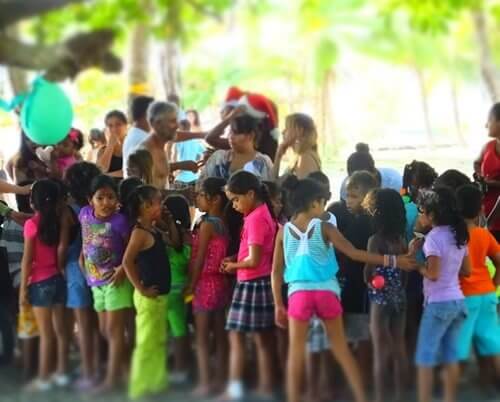
|
|
The children's Christmas fiesta.
|
The Tale of the Tico and the Gringo
Costa Ricans are some of the warmest people I have ever met, and many other foreigners have noticed that same hospitality. Most are open and gregarious and only become reserved when they think you might not speak or attempt to speak their language (perhaps thinking that you are not interested). Manners get you everywhere. A smile or a nod are among the types of wordless gestures that are greatly appreciated. The first time I offered a señora my seat on a bus, a new world opened. Not only did she give me a homemade tamale, but I suddenly became part of a chat between several people — a regular occurrence for Ticos anywhere they might be. Over time, I have met several new friends on buses, at local markets, or taking a ticket to stand in line at a bank.
Yes, there are many gringos in Costa Rica. It is, after all, the most affluent and sophisticated country in the region, stable, neutral with no military, and has ample tourism and immigration options for retirees and expats. Such factors have allowed Costa Rica to concentrate on conservation and social programs, making it more attractive internationally. "Gringo" is not simply a derogatory term, by the way. The meaning and insinuation depend upon the context and attitude of the extranjero (foreigner). Sure, there are mixed feelings among Ticos regarding the considerable influence of foreign investment on the local economy, which is relatively massive, even if the impact is often beneficial. Many Europeans and North Americans continue to move or retire to Costa Rica. So long as expats or retirees do not act arrogantly and at least attempt to speak Spanish, they are welcomed by most Ticos. Many gringos have a hard time learning the language and so tend to bond closely within their own circles — unfortunate, understandable, but ultimately their loss.
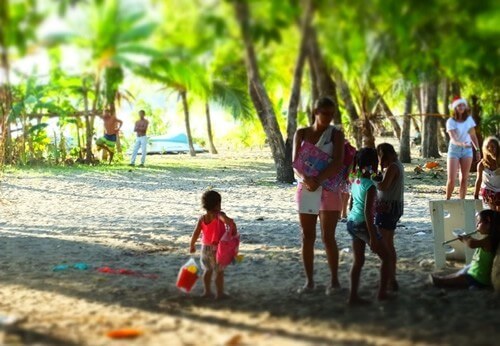
|
|
Sharing community and a piece of paradise.
|
My advice is to try to be careful about falling prey to a foreign language clique — mixing only with speakers of your language — if you wish to learn in any profound manner about the Costa Rican way of life or about any other people and their culture in general. The reality is that no matter how long you live in a foreign destination, even if you learn the language, you will always inherently be considered a foreigner at some level. In itself, some form of alienation is unavoidable. But such feelings are no excuse to be shy or open enough to strike up chats with Ticos, even if you need a dictionary or app, use hand signals to communicate, or even feel awkward using any of these ways to communicate. Ticos and expats live together on one land in Costa Rica, so why not attempt to develop creative means of dialog and develop mutually beneficial synergies?
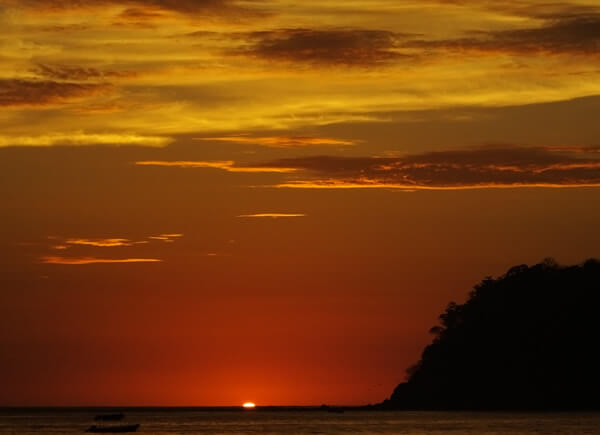
|
|
Such awe-inspiring views each evening remind you that you live in Sámara time.
|
A Slow Travel Plan
How do you travel? Whether on the cheap or seeking creature comforts, you can travel slower and longer on any budget. I travel simply and splurge every once in a while on a more expensive place or activity. However, traveling slowly and cheaply teaches you that simplicity is best and that the frivolities of luxury are better reserved for home. So leap out of your comfort zone and try these simple ways of living when in Sámara — or anywhere else:
-
Stay longer in fewer places. A month or more at best, but even a week will immerse you more in local culture than the classic “see-it-all vacation.”
-
You should only book a hostel or room in advance for a day or so, then go out and find a flat at a cheaper monthly/weekly rate. Of course, finding a room or apartment in advance is often ideal.
-
Get out and meet locals and local expats. A smile, a greeting, and showing signs of curiosity will get you everywhere.
-
Buy fresh fruit, vegetables, and seafood from local market stall vendors, pick-up trucks that drive by houses, or directly from the source.
-
Eat as the locals do. Do you absolutely need a brand of peanut butter when you are abroad?
-
Cook your own meals. Try your hand at local dishes. You will expand your repertoire and taste buds forever. You may even be able to host those who host you in their country for a meal.
-
Speak Spanish. Study or take a course and learn phrases and new vocabulary as situations present themselves. Use the new words you know, and don’t be shy.
-
Travel by bus or boat. The Costa Rican bus and ferry network is excellent, comfortable, and cheap.
-
Explore nature and local neighborhoods. It's free! Strolling about town, hiking, and exploring the natural surroundings arouse your senses, help you become familiar with the area, and will remain etched in your memory.
-
Go off the tourist trail. The surest path to immersion is to stay away from where tourists gather.
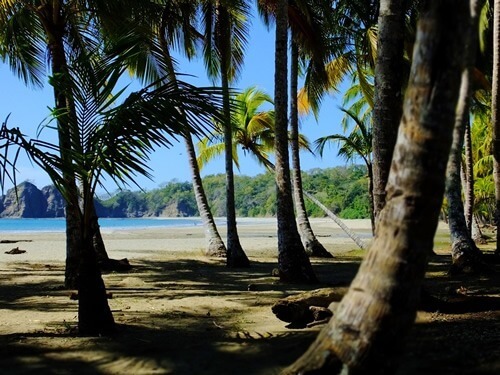
|
|
Sámara, Buena Vista, and Carillo Beaches are easily accessible.
|
Why Did I Choose Sámara?
While Sámara is a unique and enchanting place, it’s not exactly like being on a tiny tropical island with a tribe of Indio. So why did I learn about slow travel here? The way I arrived and settled down happened something like the following:
-
While living in Tico time, the paradisaic surroundings allowed me to think in peace and sharpen my senses without the distracting bustle of “western” life.
-
I learned initially from expats, met locals who spoke my language, and then began to learn Spanish (I am still far from being fluent, by the way).
-
In time, I automatically adjusted to local ways, including the food, climate, daily life, habits, and general customs.
-
In a beach town, where travelers come and go, things soon become pretty cosmopolitan. You gain a unique chance to meet all types of people around the globe and form a worldview, even while observing how the interaction affects locals.
-
When spending a long time in a place, you eventually become part of the picture where you can imagine yourself. Catching a reflection in a mirror of yourself with others can be enlightening.
Sámara just happened to be where it all came together, offering perfect conditions to teach me how to get the most out of traveling in the context of local culture. The experience and wisdom I gained in Costa Rica and in all my subsequent travels have evolved into a set of maxims that now serve as a fundamental guide.
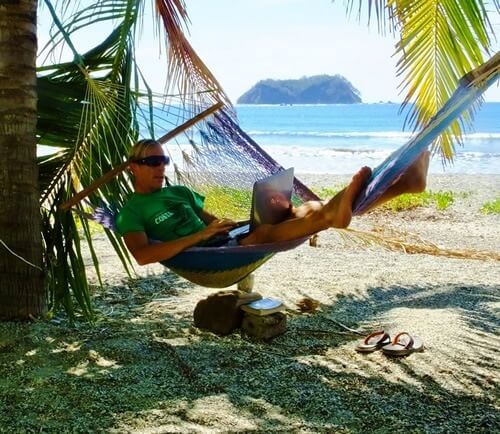
|
|
The author is appreciates and advocates for pura vida.
|
Though I have been traveling and living abroad for over 25 years, I did not realize the value and lessons learned until after my two-year stint in Playa Sámara. My return to Sámara, a long-term trip in this unique land, and visiting old and new friends have caused me to reflect on how I have changed how I travel and live. My senses are more acute. I am more open. My sense of empathy has evolved. I see every minute detail. I am more patient and less stressed. I know the importance of leading a simpler and sustainable way of living.
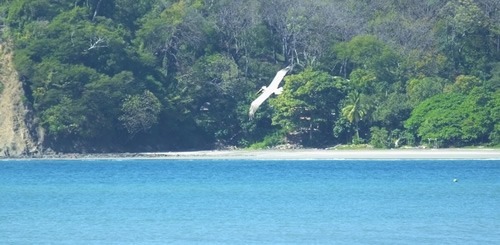
|
|
From emerald jungle to the Pacific blue, this is the Nicoya Peninsula.
|
An Insider’s Guide to Playa Sámara
Whether you practice slow travel, adventure travel on a bare-bones budget, or just cannot do without creature comforts, there are enough options for places to stay, eat, buy supplies, and plenty to do otherwise in Sámara.
The following are the places I know and trust, along with a few (essentially free) things worth doing.
Places to Stay
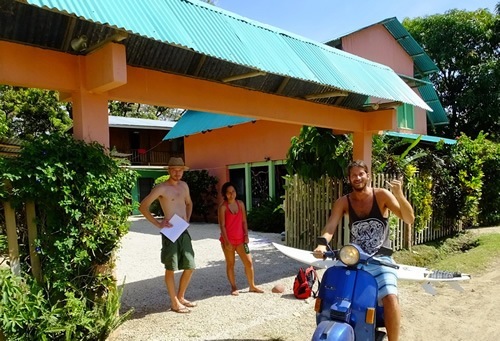
|
|
Experiencing beach life at hostel Las Mariposas.
|
Leonie, a Dutch Sámara expat, opened the second hostel just as I left four years ago. Hostel Las Mariposas is just off the beach near Intercultura Language School. The colorful garden-style house has mixed or female dorms, private rooms, lots of green communal space and hammocks, and a kitchen where there’s always something going on. Being in town, it’s close to everything yet still secluded. Leonie even takes on the occasional volunteer. (See #2 on the map below.) There are several hostels in Sámara.
Koss Gallery Private Beach Bungalows
Right next door to Miguel and Sarah lives local legendary Tico artist Jaime Koss. He offers two fine beach apartments with WiFi in a 2-story bungalow next to and above his beachfront home, open-air studio, and gallery. (See #5 on the map below.)

|
|
Map of Sámara locations mentioned above — courtesy of Google Earth
|
Otras Alquileres (Other Rentals)?
Yes, if you search deeper or locally, there are many other short- or long-term rentals, as alternatives to hotels. The occasional Craigslist ad and Couchsurfing opportunities exist as well. Also, look around for rental signs (Se Alquila) My tip: Ask at the small local supermarkets as most shop owners have or know of something — often far cheaper than the usual tourist rates.
|
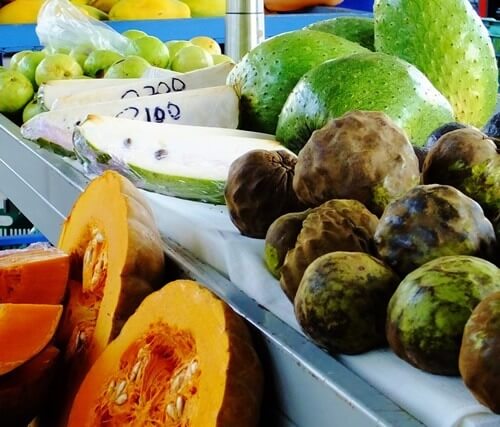
|
|
Strange and delicious fruits anytime — perfect for a refreshing batido smoothie.
|
Comida Tipica
Some say Comida Tipica, typical food, is rather hum-drum in Costa Rica. Rice, beans, potatoes, fried plantains, salad, and meat or fish, known as Casado, are certainly simple, yet eating such a meal — even in the Pacific heat — will likely grow on you. Naturally, there are many other dishes and loads of fresh, exotic fruits and vegetables for home cooking. It seems many people are quite lean on the coast of Costa Rica, and low-calorie diets are typical (another characteristic of the Blue Zone regions), which are rather healthy.
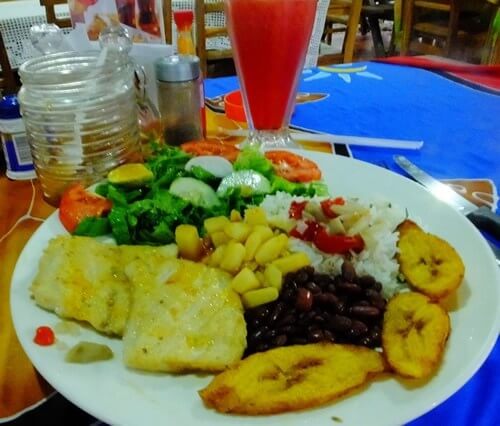
|
|
Casado is a typical dish that will grow on you.
|
Going out to eat in Sámara is tempting. International and Tico infusion menus, as well as comida tipica dishes and vegan food, can be found in the beach café scene and all over town. However, I do love my Casado at Colochos Restaurant, tacos at Lo Que Hay on the beach, and the meat or fish dishes grilled over coconut wood at El Lagarto Restaurant, which, though pricey, are delicioso!
Learning Spanish in Sámara
Need an excuse to stay in town for a while? Enroll in various Spanish language and culture courses at Intercultura Language School, while studying on the beach. It's a perfect start for long-term travel in Latin America, just getting the basics, brushing up on existing Spanish — or even yoga!
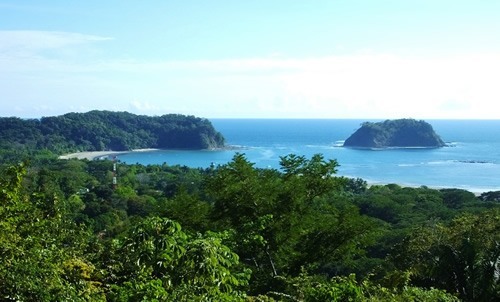
|
|
Relax on the beach or explore the unforgettable natural surroundings.
|
Into the Blue
With the Pacific Blue on your doorstep, you will likely spend some time in the warm yet cool thermocline sluiced waters. If you prefer more than just the occasional dip, see the following options:
-
Swim out to Sámara’s satellite Isla Chora in the bay to the far South end of the beach past Matapalo. Of course, you could just rent a kayak at a beachside surf school.
-
Go snorkeling from the same spot, entering opposite the stony reef that stretches halfway toward the island. This is the only coral reef in Sámara, and though white and calcified, it is a great place to see colorful tropical fish and plant life.

|
|
Traversing the bizarre rocky landscape toward Buena Vista — a hiker-climber paradise.
|
Hike, Walk, Adventure
-
Walk north to neighboring dark, sandy Playa Buena Vista. Time your walk with the low tides, with ample time before sundown. Wear hiking boots or at least sneakers, as you will do lots of uneven rock hopping, traversing tide pools, and a river crossing. The hike is a good 4km (2.5 miles) each way.
-
Hiking beyond the southern headland takes you to the equally empty white beach of Playa Carillo. Hiking along the rocky coast, cliffs, and ocean will cut you off except at the lowest tidal phases. You must find an off-trail route across the jungle-topped point — or take the road.
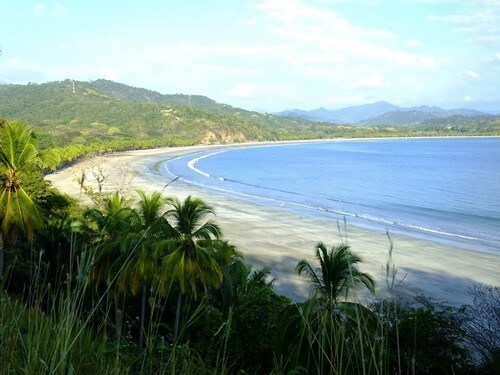
|
|
Playa Carillo is said to be one of the most beautiful, pristine beaches on the Nicoya Peninsula.
|
-
I enjoyed the zipline canopy tour with Wingnuts. It is responsible for adventure tourism at its best, as it is built while preserving the trees on land reserved for wildlife habitat. The tour includes 10 ziplines, hanging bridges, wildlife, and ocean vistas ($75 high season).
-
Inland Hikes are peaceful walks on rocky dirt roads or jungle trails, such as ascending the steps off the main road opposite Las Brisas Hotel to the overlooking hill or toward Santa Domingo, leaving east behind Matapalo. If you are observant, you will experience plenty of natural beauty, ocean views, and wildlife glimpses (at least birds and howler monkeys) (#6 & 7 on the map above.)

|
|
Going inland almost guarantees seeing Howler Monkeys, which you will hear regardless.
|
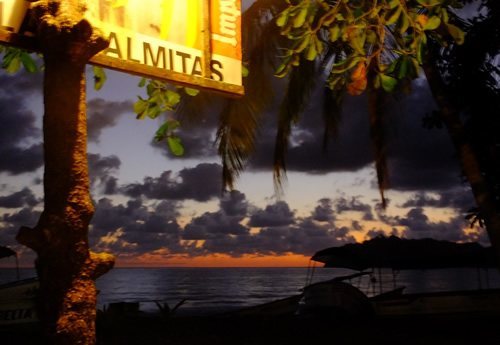
|
|
Night falls over a paradise.
|
Ode to Playa Sámara
Sámara has also changed, but it remains within its size and infrastructure boundaries. The growth of Sámara maintains the sustainability of its inherent beauty. It is no longer the well-kept secret it once was, but a good thing tends to catch on.
Traveling slowly, you will have ample time to learn how vital preservation, culture, and sustainability are today — not just in Sámara. So please visit and stay awhile, but leave the land as you first discovered it. Let us hope that Sámara’s future remains under the bright stars under which it still appears each night in perfect clarity.
Paul Graham France is a British-American nomad adventurer who has traveled slowly across the planet thus far, including living in Germany, Spain, Costa Rica, and Brazil. He has been publishing articles, mostly on travel, since 2011.
|
